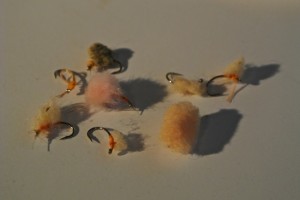 Trying to do my winter deal today, getting ready for the Bahamas, gearing up for a 24-hour mountain bike race in 2013, trying to shave off a few pounds and hit the weights. So I was driving to a health club earlier, ready to sweat, when I crossed the Bitterroot River.
Trying to do my winter deal today, getting ready for the Bahamas, gearing up for a 24-hour mountain bike race in 2013, trying to shave off a few pounds and hit the weights. So I was driving to a health club earlier, ready to sweat, when I crossed the Bitterroot River.
We’re anglers. Can’t cross a ditch without looking for a rise, right? Well, I looked at my temperature gauge and it said 38 degrees. Plenty warm. Then I looked at the river and thought I saw a rise.
Got done with the workout and while I was driving home I crossed the Bitterroot again—and two wader-clad dudes were gearing up. That should of been me, I cursed. And maybe it will be tomorrow. Just got to see how the week shapes up. The point is, we are almost there. In another two weeks, maybe three, some rainbows will be working toward the mouths of feeder creeks, gearing up for their spawning runs. In about a month or so the first big skwala stoneflies will be coming off in western Montana and their presence will remain into May. Baetis hatches should start in March, too. As amazing as it sounds, we’re on the cusp of quality trout fishing in the northern Rockies.
Which brings me to this question: What is your favorite spring setup?
I’ll explain mine here. It’s so rudimentary it’s almost embarrassing. What I like about this combination, however, is that the patterns are easy to tie so you don’t have to worry about breaking your rig off on the bottom, which is usually where you need to place this setup to catch fish. And what is that setup? Greg’s Incredible Egg and a standard Flashback Pheasant Tail Nymph.
I catch more fish on the egg than I do on the PT. And that’s good because I can tie the egg pattern in about 15 or 20 seconds. All I do is take a scud hook, typically a size 16, and wrap orange thread onto it, covering the hook and leaving the thread, ultimately, hanging near the center of the hook. Then I take a little pinch of egg material and pinch it to the hook. I wrap the thread over the center of the egg yarn then wrap behind the yarn and in front of the yarn. Then I wind the thread to the hook eye and whip finish. I don’t even bother gluing the head. If you’re off center with your egg material don’t even worry. It doesn’t matter! The fish aren’t picky during spring and they will eat the thing as long as it’s pink or orange and drifting in a river.
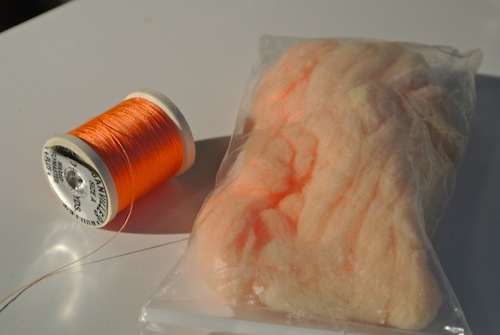
These are the tools for the GIE. Orange thread and some egg material. Tie it to a size 16 scud hook and prepare to slay this late winter and spring.
The PT nymph is a little different, although they, too, don’t need to look fly-bin ready. The key to my PT patterns is that I tie them super slim and only cover the material with a fine, fine copper wire. I don’t put a bead on the head because it’s just not necessary and I don’t want to deal with whitefish, which are super-attracted to flashy patterns. I don’t put flash in the pattern at
all. It’s just a standard drab pattern with an overwing of straight pheasant tail fibers. A little hare’s ear dubbing offers the impression of legs—makes the thing look buggy. But overall it’s just a slim dude ready for action.
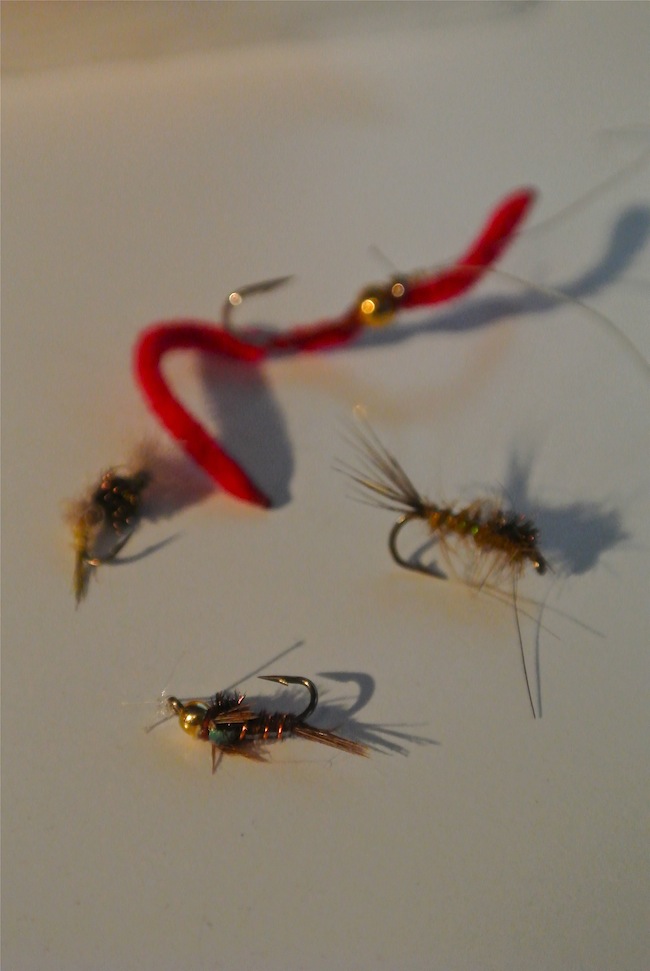
Here are some great spring patterns. I fish the smaller patterns behind the GIE. If I don’t fish a GIE at the point, I use a San Juan Worm instead. The fly in the foreground is a little flashy for my liking but the one to the right and behind it is good. That’s a hare’s ear. I tie my PT’s in that style, just with a shorter tail and two or three pheasant tail fibers for the body and overwing. I use super-thin copper wire to keep it all in place.
I fish those flies with or without an indicator. I’ve always felt that you can learn how to fish nymphs best by not using an indicator, but an indicator makes things easy for sure. Up to you. Under the indicator and attached just a few inches above the GIE are split shot, which gets the offering to the bottom quickly. That’s where you need to be so there’s no reason to wait for your patterns to sink slowly. Put some lead on the leader and get those suckers down. Two split shot. Three split shot. Five split shot? Depends on the depth and speed of the water you’re fishing and what size shot you’re using. I don’t like cannonballs. I prefer BB split shot. I attach as many of those as I need to get down. Then the eating begins.
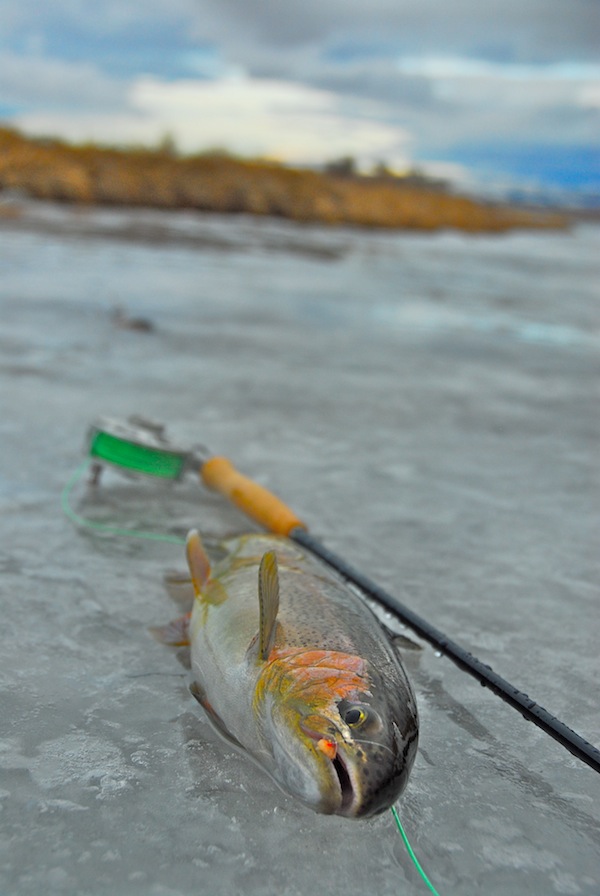
This combination is so simple and, yet, so productive. Here’s a nice Madison River ‘bow that fell for the GIE.
There are lots of patterns out there that work well in spring, such as suped-up PT’s with flash on the wingcase and beadheads, etc. There are all sorts of San Juan worms, which are a killer spring pattern. There are Hare’s Ears and thread midges and such and there’s no reason you shouldn’t fish those patterns, too. I’m just saying, tie some GIE’s and some standard PTs and you’ll be good to go, starting in a couple weeks, lasting through spring.
Don’t forget, I’d love to hear what your favorite spring setups are.
Here’s more proof that you ought to be tying and fishing the GIE.

Deep, slow water is where you’ll find trout during later winter and early spring. This is Montana’s Madison River in the Beartrap Canyon. Great, great spring fishing can be had here. Run those GIE’s and PT’s through the slots and you’ll score bigtime, with up to 30 fish in a day.

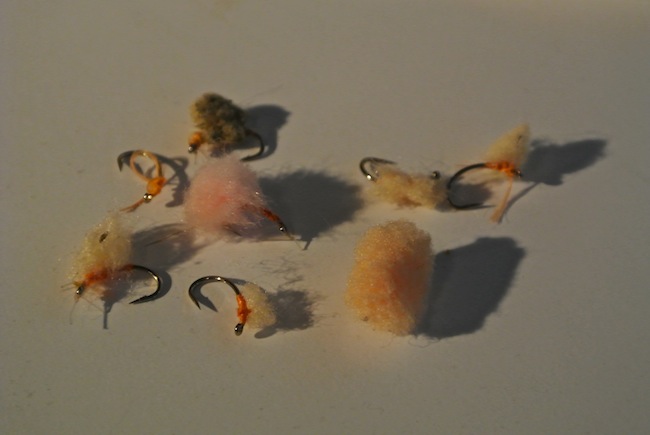
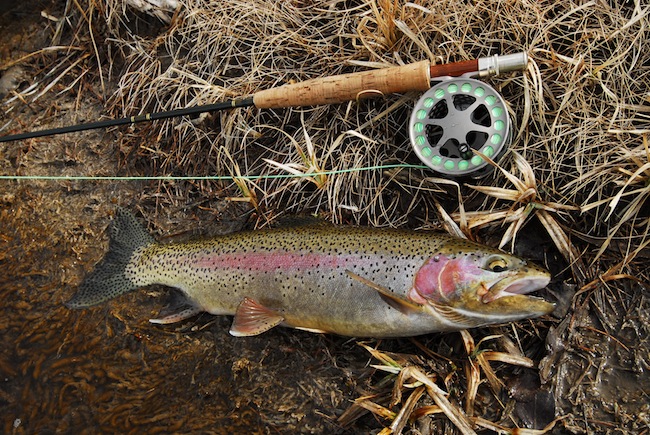
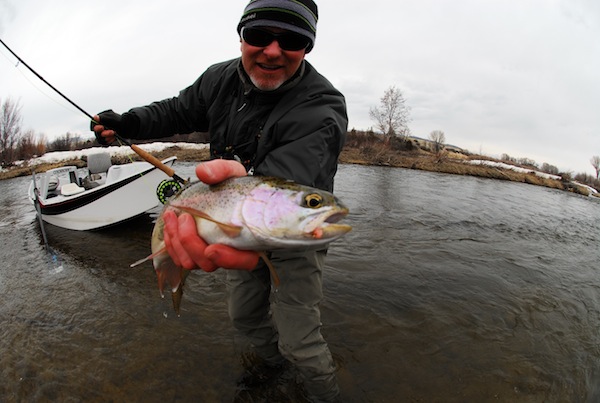
3 Responses to The Greatest Spring Fly for the Northern Rockies